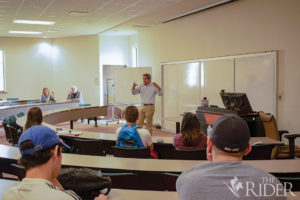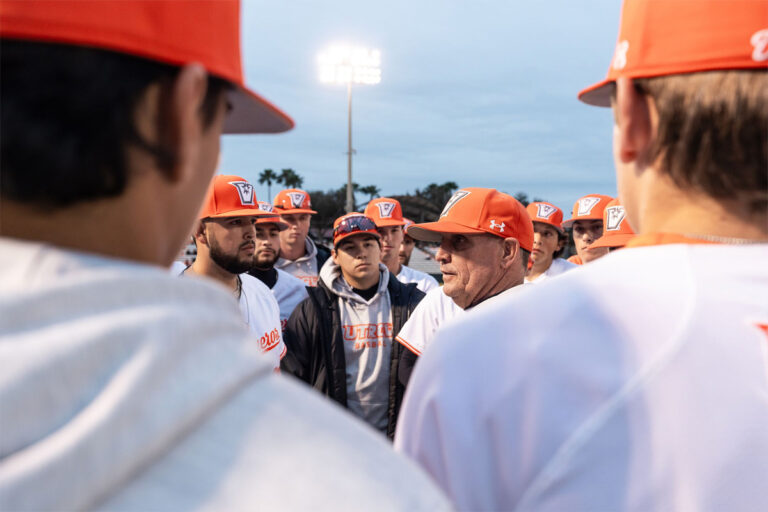More than 50 students and faculty members attended a presentation by New York Times reporter Manny Fernandez on the Brownsville campus.
“Manny Fernandez has been living down here in the [Rio Grande] Valley for about two months because The New York Times said most of the things happening in this region of the country, the big stories, are here in the Valley,” said William Strong, a professor in the Communication department. “So, he’s been here writing about immigration, the border wall, coyotes [human smugglers], narcos, a little of everything that it’s kind of, like, common life for us down here. I’ve read a lot of his stories that are published in The New York Times and it’s interesting that we are often, kind of like, ‘front-page material’ so far away.”
Strong and Fernandez met two years ago, when Fernandez had questions about “Texology,” which Strong refers to as “all things Texas.”
“So, he quoted me for his stories and I quoted him for my radio show and in my books,” Strong said in the presentation on March 29. “It’s a good support system we have.”
Fernandez, who has been working with The New York Times since 2005, has been living in Houston for about eight years after a position opened in Texas while he was still in Brooklyn.
“I was covering ‘New York City’ for the Times in New York City and the Texas position opened up and I raised my hand for it,” he said. “They selected me and, so, I moved my wife and my son from Brooklyn to Houston. A couple months ago, my editors wanted to deepen and increase our border coverage and the idea was, ‘Let’s have someone live down there full time’ to sort of look for the things we are missing.”
Fernandez said he has covered the border before for different types of stories, but living on the border has been an amazing experience because it has given him a whole different perspective.
“I’ve covered the border before,” he said. “I’ve been here for a lot of different types of stories but my eyes are opening and different dots are connecting. It’s been an amazing experience.”
In the presentation, Fernandez spoke about the importance of the First Amendment in the United States and his own personal experiences with it as a journalist.
“The First Amendment is a living, breathing thing in my life,” he said. “It’s not some abstract concept or something in a book, it kind of hangs on to anything I do. So invisibly, sometimes, that you have to stop and think about it.”
The reporter shared a recent experience he had with a piece he wrote on the traffic checkpoints to demonstrate to the audience how strong the First Amendment is in this country, and how crucial it is for his job as a journalist.
“I wrote a short piece, it was first person, meaning I was writing about myself and the traffic checkpoints on the border,” he said. “So, like, the checkpoint in Falfurrias, which I am very familiar with, what they are and the way in which that level of government, sort of intrusion and interest in people, is sort of normal for everyone that lives here, but for a lot of people in other parts of the country, that level of questioning and asking, ‘Can you pop the trunk? Where are you headed? Who’s in the vehicle?’ That’s sort of a shock to many people around the country.”

As part of his article, Fernandez drove to the checkpoint in Falfurrias to narrate the story of his own experience as a Mexican-American journalist going through the checkpoint.
“I pull up to the checkpoint and the agent who is standing there sort of leans in and sees that I have a photographer taking pictures in the passenger seat and he says, ‘Are you a U.S. citizen?’ and I say, ‘Yes, sir’ and as he goes in the car, he kind of shields himself. He doesn’t want to be photographed,” Fernandez said. “And, so, he kind of just put his arm up like a sort of shield.”
Fernandez asked the audience to think about other countries in which reporters can go to an officer and take photos without causing an altercation.
“He obviously sees that I’m some kind of reporter,” he said. “He sees a photographer taking pictures, and all he does is just do a little bit of, like, a shield, hoping to maybe hide his face a little bit, but he’s not terribly worried about it. In how many other countries can you go to and be a reporter, pull up to a police checkpoint with a photographer shooting away pictures and come right up to an agent and have the agent not say anything?
“Not harass you, not ask you, ‘Why are you filming me and what is this for?’ or ‘Are you really a reporter, can I see your media credentials?’ It would happen in a lot of countries where the agent would be like, ‘Whoa, who are you? Why are you filming me? Stop what you are doing; this is a police checkpoint. Pull over and let’s sort this out.’”





